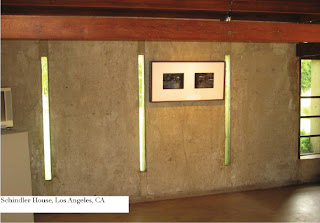Text & Photos by Rob Forbes
"Light is not so much something that reveals, as it is itself revelation." - James Turrell
One of the best lighting "exhibitions" I ever witnessed was "staged" on a spring day in a small cafe in Mallorca, Spain. (It could have been anywhere). We were finishing a leisurely lunch and coffee, enjoying the seaside quiet, when a bus arrived and disgorged a swarm of large, loud tourists, thoroughly dismantling the mood both visually and acoustically. We sat waiting impatiently for the check, annoyed by the sudden change to the environment, eager to get away from the tourist invasion.
Suddenly the sun appeared from behind the clouds, blanketing the cafe and patrons in a pattern of vivid light dots that shone through the perforated awning. The atmosphere underwent a complete transformation. Bodies retreated into the background, like deer camouflaged in a forest, and we left the place calm and amused, not irritated. It reminded me that light and its patterns can have a profound effect on any environment. It can change our mood from irritation to tranquility in a second.
We cannot really credit the person who designed the perforated awning as the visionary behind this lighting "exhibition". Many unrelated things (none of which were designed with the intention of creating the dot matrix) coalesced to create the effect. It was an act of nature, a form of lighting design that we often take for granted. Design that it is not in a showroom, not trying to be celebrated as design, is so often overlooked. But it's all around us at every waking moment. Missing its magic is like forgetting to notice the beauty of nature.
Lighting is a design category unto itself. Like music, it is magical and mysterious and sets up a deep primal resonance in us that connects us to the natural world. It acts directly on our psyches, creating and changing moods and feelings. This may be why the experience of viewing the stars on a pitch-black night, or catching a glorious sunrise or sunset, or stirring flames in a fireplace can be such a powerful experience for us. Light runs deep and affects everything it touches.
"The finest thing we can experience is the mysterious. It is the fundamental emotion which stands at the cradle of true art and true science. He who does not know it and can no longer wonder, no longer feel amazement, is as good as dead, a snuffed-out candle." - Albert Einstein
Nature provides us with the most amazing light exhibitions everyday and the exhibition is always changing (thanks and kudos to the curator). Architects have been helping us to see the magic of light as far back as we know. I have included photos of some of my favorite "lighting solutions" taken over the years. The first is the Pantheon in Rome with an oculus that brings light to a silent dark mysterious chamber. Another comes from a courtyard in Cordoba Spain and another comes from an interior in Granada. Light and shade patterns from Louis Kahn's Kimbell Art Museum, light strips at the Schindler house in West Hollywood, a Turnbull wooden chapel in St. Helena California, a doorway from the Luis Barragan's Convento de las Capuchinas Sacramentarias an Tlalpan, Mexico City, are other examples. Each of these reminds us to consider light and the absence of light, pattern, space, and the magic of our physical world more fully. Architects can be extraordinary lighting designer.
Modern lighting designers are primarily focused on problem solving tasks, i.e. how to make our environments more efficient, comfortable and functional. Fine, but one of the lighting's other tasks might be to rekindle our interest in the character, magic, and elusive nature of light itself. The better designers do this unwittingly I believe. The perforations in the dome of Castiglioni's Arco could have derived from seeing sunlight spots on people or on forms just as I witnessed in that cafe on Mallorca. You cannot really look at Ron Gilad's Wall Piercing without a nod to the ephemeral quality of natural lighting. There are many other examples.
I'm treated to a light exhibition every morning from my apartment in San Francisco. The more dramatic and colorful lightscapes is perhaps the more seductive, but I'm partial to the other one. I see the lights on the buildings and the headlights from the cars and the neon cafe signage and it makes me realize that lighting is all around us in its magical form, if we choose to see it. Light is truly mysterious - even Galileo admits to understanding it "but little".
"Vision, I say, is related to light itself. But of this sensation and the things pertaining to it I pretend to understand but little. Even a long time would not suffice to explain that trifle, or even to hint at an explanation, I pass over this in silence." - Galileo Galilei, The Assayer
Rob Forbes' career includes work in both the Arts and Business fields. Forbes is best known as the Founder of Design Within Reach and for the vision of a business that has grown into one of the leading retail destination for modern design in the US. In his role there he edited a weekly online newsletter, Design Notes, that covered design broadly around the globe. His interests in design, culture, and the urban environment and his personal passion for bicycles led him to his new venture PUBLIC. PUBLIC is a design based business based in San Francisco with a mission to help reduce our dependency on cars and think more intelligently and artfully about the way we get around and connect with our cities and communities. PUBLIC launched in May 2010 in San Francisco and had become the leading nationwide direct source (www.publicbikes.com) for elegant modern city bikes and gear in the US. (text courtesy of Rob Forbes)




















No comments:
Post a Comment